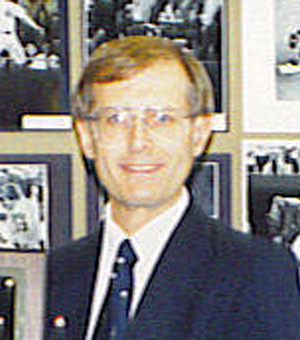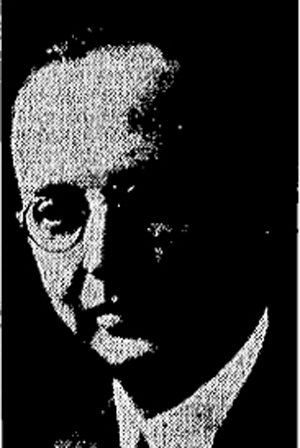SABR announces 2012 Chadwick Award recipients
The Society for American Baseball Research is pleased to announce the 2012 recipients of the Henry Chadwick Award, established to honor the game’s great researchers—historians, statisticians, annalists, and archivists—for their invaluable contributions to making baseball the game that links America’s present with its past.
The 2012 recipients of the Henry Chadwick Award are:
 Robert Creamer (1922-2012), a prolific baseball writer whose 1974 biography of Babe Ruth, Babe: The Legend Comes to Life, stands as a monument of the craft. A writer and senior editor for Sports Illustrated from its 1954 inception until 1984, Creamer also wrote Stengel: His Life and Times and Baseball in ’41, and contributed to several other baseball histories. But it was his research and prose about The Bambino which laid the path for the many great sports biographies that have followed. It was the first comprehensive biography about Ruth since his death in 1948. Creamer, who as a boy saw Ruth hit home runs at Yankee Stadium but never met the man, interviewed hundreds of his former teammates and friends to chronicle Ruth’s legendary on-the-field feats and his equally prodigious off-the-field controversies. His book was also timely — published the same year Hank Aaron broke Ruth’s career home run record of 714. It remains arguably the definitive account of the Hall of Fame slugger’s life.
Robert Creamer (1922-2012), a prolific baseball writer whose 1974 biography of Babe Ruth, Babe: The Legend Comes to Life, stands as a monument of the craft. A writer and senior editor for Sports Illustrated from its 1954 inception until 1984, Creamer also wrote Stengel: His Life and Times and Baseball in ’41, and contributed to several other baseball histories. But it was his research and prose about The Bambino which laid the path for the many great sports biographies that have followed. It was the first comprehensive biography about Ruth since his death in 1948. Creamer, who as a boy saw Ruth hit home runs at Yankee Stadium but never met the man, interviewed hundreds of his former teammates and friends to chronicle Ruth’s legendary on-the-field feats and his equally prodigious off-the-field controversies. His book was also timely — published the same year Hank Aaron broke Ruth’s career home run record of 714. It remains arguably the definitive account of the Hall of Fame slugger’s life.  Tom Heitz (1940- ) was the National Baseball Hall of Fame Librarian for 12 years beginning in 1983. He oversaw a construction project that greatly enlarged the building and made it a modern facility, grew the collections and services, provided for the conservation of materials and expanded access to researchers. “Up to that point,” he told The Baltimore Sun in 1994, “it was a private hunting preserve for scholars and the privileged.” As Hall of Fame Librarian, he first proposed and then helped establish SABR’s Seymour Medal, first awarded in 1996, to honor the best book of baseball history or biography published during the preceding calendar year. After serving in the United States Marine Corps, Heitz worked as an assistant law librarian at the University of Puget Sound and later as a law librarian for the Attorney General of New York before joining the Hall of Fame staff. For 10 years, he served as the official scorekeeper for the Oneonta Tigers of the New York-Penn League. He now serves as general manager of Friends of Doubleday, a nonprofit organization dedicated to the preservation of Doubleday Field in Cooperstown, New York.
Tom Heitz (1940- ) was the National Baseball Hall of Fame Librarian for 12 years beginning in 1983. He oversaw a construction project that greatly enlarged the building and made it a modern facility, grew the collections and services, provided for the conservation of materials and expanded access to researchers. “Up to that point,” he told The Baltimore Sun in 1994, “it was a private hunting preserve for scholars and the privileged.” As Hall of Fame Librarian, he first proposed and then helped establish SABR’s Seymour Medal, first awarded in 1996, to honor the best book of baseball history or biography published during the preceding calendar year. After serving in the United States Marine Corps, Heitz worked as an assistant law librarian at the University of Puget Sound and later as a law librarian for the Attorney General of New York before joining the Hall of Fame staff. For 10 years, he served as the official scorekeeper for the Oneonta Tigers of the New York-Penn League. He now serves as general manager of Friends of Doubleday, a nonprofit organization dedicated to the preservation of Doubleday Field in Cooperstown, New York.  F.C. Lane (1896-1984) was the editor and a prolific writer for Baseball Magazine from 1912 through 1937. The author of hundreds of editorials, interviews and articles about how the game was or should be played, Lane wrote forward-thinking pieces about, for example, how batting average could be misleading, opining that different batting outcomes should have different weights. It would be a few more generations before his wisdom began to win the day. Batting, the only baseball book published by Lane in 1925, holds a special interest for sabermetrically inclined readers today with its insights on how writers in the first quarter of the twentieth century viewed the science and art of hitting. (SABR reprinted this book in paperback form in 2001.) After leaving Baseball Magazine, Lane edited the annual Little Red Book of Major League Baseball from 1937 through 1948 while spending a brief stretch in academia at Piedmont College in Demorest, Georgia. He later wrote five books on nature and published a collection of poems. As Jack Kavanagh wrote in 1996, “A graceful writer, an erudite man, F. C. Lane was more than a contributor to the written word of baseball’s past. He was an adornment.”
F.C. Lane (1896-1984) was the editor and a prolific writer for Baseball Magazine from 1912 through 1937. The author of hundreds of editorials, interviews and articles about how the game was or should be played, Lane wrote forward-thinking pieces about, for example, how batting average could be misleading, opining that different batting outcomes should have different weights. It would be a few more generations before his wisdom began to win the day. Batting, the only baseball book published by Lane in 1925, holds a special interest for sabermetrically inclined readers today with its insights on how writers in the first quarter of the twentieth century viewed the science and art of hitting. (SABR reprinted this book in paperback form in 2001.) After leaving Baseball Magazine, Lane edited the annual Little Red Book of Major League Baseball from 1937 through 1948 while spending a brief stretch in academia at Piedmont College in Demorest, Georgia. He later wrote five books on nature and published a collection of poems. As Jack Kavanagh wrote in 1996, “A graceful writer, an erudite man, F. C. Lane was more than a contributor to the written word of baseball’s past. He was an adornment.”  Ray Nemec (1929-2015) had already spent 30 years traveling throughout the Midwest tracking down minor league box scores before SABR was founded in 1971. One of SABR’s sixteen original members and the first chairman of SABR’s Minor Leagues Research Committee, he was a pioneer in compiling and correcting the lifetime records of professional players at all levels. Hall of Fame historian Lee Allen called him “the foremost authority on minor league players.” Ray was instrumental in the 1978 publication of SABR’s Minor League Stars, the first comprehensive listing of career records for minor league players, and his work has appeared many times in The Sporting News and other publications. He says he enjoys compiling statistics for minor or independent leagues that never included their information in the annual Spalding or Reach baseball guides that served as the official league record books for most of the 20th century. He lives outside Chicago and is retired after a 45-year career as a sales associate and other positions for Best Foods Inc. (then Corn Products Company International.)
Ray Nemec (1929-2015) had already spent 30 years traveling throughout the Midwest tracking down minor league box scores before SABR was founded in 1971. One of SABR’s sixteen original members and the first chairman of SABR’s Minor Leagues Research Committee, he was a pioneer in compiling and correcting the lifetime records of professional players at all levels. Hall of Fame historian Lee Allen called him “the foremost authority on minor league players.” Ray was instrumental in the 1978 publication of SABR’s Minor League Stars, the first comprehensive listing of career records for minor league players, and his work has appeared many times in The Sporting News and other publications. He says he enjoys compiling statistics for minor or independent leagues that never included their information in the annual Spalding or Reach baseball guides that served as the official league record books for most of the 20th century. He lives outside Chicago and is retired after a 45-year career as a sales associate and other positions for Best Foods Inc. (then Corn Products Company International.)  David W. Smith (1948- ) founded Retrosheet in 1989 and has been its leader ever since. A prolific researcher in his own right, Smith’s dream of collecting the play-by-play for thousands of games has been surpassed: as of 2012, more than 120,000 play-by-play accounts are available on Retrosheet’s website, comprising about 60 percent of the major league games in history. Retrosheet is the backbone of so much historical and statistical research, and Smith’s vision and generosity have greatly influenced the research community over the past 20 years. In 2005, Smith was the recipient of the Bob Davids Award, SABR’s highest honor. In 2001, he received the SABR Salute and also won the convention award for best research presentation with “Play by Play Analysis of the 1951 National League Pennant Race”. A longtime professor of microbiology at the University of Delaware, Smith is a lifelong Dodgers fan who can frequently be found sporting his Brooklyn Dodgers jerseys at the SABR convention.
David W. Smith (1948- ) founded Retrosheet in 1989 and has been its leader ever since. A prolific researcher in his own right, Smith’s dream of collecting the play-by-play for thousands of games has been surpassed: as of 2012, more than 120,000 play-by-play accounts are available on Retrosheet’s website, comprising about 60 percent of the major league games in history. Retrosheet is the backbone of so much historical and statistical research, and Smith’s vision and generosity have greatly influenced the research community over the past 20 years. In 2005, Smith was the recipient of the Bob Davids Award, SABR’s highest honor. In 2001, he received the SABR Salute and also won the convention award for best research presentation with “Play by Play Analysis of the 1951 National League Pennant Race”. A longtime professor of microbiology at the University of Delaware, Smith is a lifelong Dodgers fan who can frequently be found sporting his Brooklyn Dodgers jerseys at the SABR convention.
By honoring individuals for the length and breadth of their contribution to the study and enjoyment of baseball, the Chadwick Award will educate the baseball community about sometimes little known but vastly important contributions from the game’s past and thus encourage the next generation of researchers.
The criteria for the award reads in part: The contributions of nominees must have had public impact. This may be demonstrated by publication of research in any of a variety of formats: books, magazine articles, websites, etc. The compilation of a significant database or archive that has facilitated the published research of others will also be considered in the realm of public impact.
For a complete list of Chadwick Award winners, click here.
Originally published: February 17, 2012. Last Updated: February 17, 2012.


